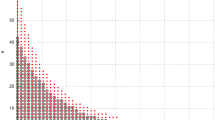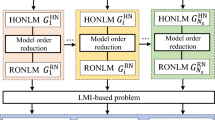Abstract
This study focuses on the question of the stability analysis of complex interconnected nonlinear systems using the property of Lyapunov and Finsler. The main idea is to minimize the effect of interconnections between the subsystems, for that, we use the Lyapunov function and the H∞ control, then applying Finsler’s lemma to release the conditions of stability, the independent matrices allow to obtain less conservative results. The proposed control approach is formulated in a minimization problem and derived in terms of linear matrix inequalities (LMIs) whose resolution yields the decentralized control gain matrices. All the developed results are tested on two representative examples and compared with some recent previous ones.





Similar content being viewed by others
References
Abbaszadeh M, Marquez HJ (2012) A generalized framework for robust nonlinear H∞ filtering of Lipschitz descriptor systems with parametric and nonlinear uncertainties. Automatica 48(5):894–900
Bernussou J, Titli A (1982) Interconnected dynamical systems: stability, decomposition and decentralization, North-Holland
Cheng Q, Cui B (2019) Improved results on robust energy-to-peak filtering for continuous-time uncertain linear systems. Circ Syst Signal Process 38:2335–2350. https://doi.org/10.1007/s00034-018-0965-7
Hwang JD, Hsiao FH (2003) Stability analysis of neural-network interconnected systems. IEEE Trans Neural Netw 14(1):201–208. https://doi.org/10.1109/TNN.2002.806643
Li J et al (2010) H∞ performance for a class of uncertain linear time-delay systems based on LMI. Int Conf Educ Technol Comput 5:344–348. https://doi.org/10.1109/ICETC.2010.5530057
Lin WW et al (2007) A novel stabilization criterion for large-scale T–S fuzzy systems. IEEE Trans Syst Man Cybern Part B Cybern 37(4):1074–1079. https://doi.org/10.1109/TSMCB.2007.896016
Mahmoud MS, Almutairi NB (2009) Decentralized stabilization of interconnected systems with time-varying delays. Eur J Control 6:624–633. https://doi.org/10.3166/ejc.15.624-633
Mahmoud MS, Al-Sunni FM (2010) Interconnected continuous-time switched systems: robust stability and stabilization. Nonlinear Anal Hybrid Syst 4(3):531–542. https://doi.org/10.1016/j.nahs.2010.01.001
Souza M, Wirth FR, Shorten RN (2017) A note on recursive Schur complements, Hurwitz stability of Metzler matrices and related results. IEEE Trans Autom Control 62:4167–4172. https://doi.org/10.1109/TAC.2017.2682032
Srdjan Stanković S, Siljak D (2009) Robust stabilization of nonlinear interconnected systems by decentralized dynamic output feedback. Syst Control Lett 58(4):271–275. https://doi.org/10.1016/j.sysconle.2008.11.003
Thanh Nguyen T, Phat Vu N (2012) Decentralized H∞ control for large-scale interconnected nonlinear time-delay systems via LMI approach. J Process Control 22(7):1325–1339
Wang WJ, Lin W (2005) Decentralized PDC for large scale TS fuzzy systems. IEEE Trans Fuzzy Syst 13(6):779–786. https://doi.org/10.1109/TFUZZ.2005.859309
Zhang Y, Pheng AH (2002) Stability of fuzzy control systems with bounded uncertain delays. IEEE Trans Fuzzy Syst 10:92–97. https://doi.org/10.1109/91.983283
Zhu Y, Pagilla PR (2007) Decentralized output feedback control of a class of large-scale interconnected systems. IMA J Math Control Inf 24:57–69. https://doi.org/10.1093/imamci/dnl007
Zouhri A, Boumhidi I (2015) Decentralized control of interconnected systems with time-delays. 12th ACS/IEEE International Conference on Computer Systems and Applications AICCSA 2015 November 17-20, Marrakech, Morocco. https://doi.org/10.1109/AICCSA.2015.7507224
Zouhri A, Boumhidi I (2016) Decentralized robust H∞ control of large scale systems with polytopic-type uncertainty. Int Rev Autom Control (IREACO) 9(2):103–109. https://doi.org/10.15866/ireaco.v9i2.8728
Zouhri A, Boumhidi I (2017) Decentralized H∞ control of interconnected systems with time-varying delays. CIT J Comput Inf Technol 25(3):167–180
Zouhri A, Benyakhlef M, Kririm S, BOUMHIDI I (2016) Robust stability and H∞ analysis for interconnected uncertain systems. Int J Math Stat 17(1):55–66
Author information
Authors and Affiliations
Corresponding author
Additional information
Publisher’s note
Springer Nature remains neutral with regard to jurisdictional claims in published maps and institutional affiliations.
Appendix
Appendix
1.1 Decentralized State Feedback H∞ Control
In this Appendix, we verify the inequality (19) used in section 3, with:
Apply the lemma of the square matrix, we have:
Then
Since
Inequality (A.4) can be rewritten as follows:
Finally, the inequality (24) is verified.
Rights and permissions
About this article
Cite this article
Zouhri, A., Boumhidi, I. Stability analysis of interconnected complex nonlinear systems using the Lyapunov and Finsler property. Multimed Tools Appl 80, 19971–19988 (2021). https://doi.org/10.1007/s11042-020-10449-9
Received:
Revised:
Accepted:
Published:
Issue Date:
DOI: https://doi.org/10.1007/s11042-020-10449-9




